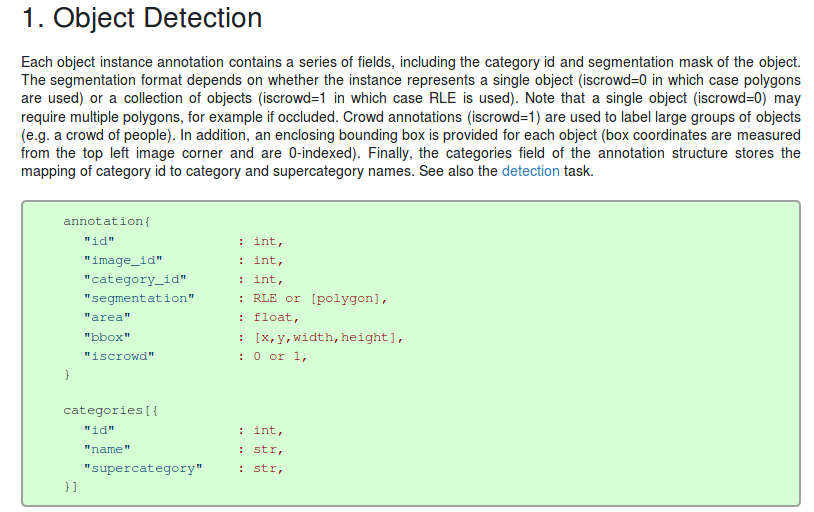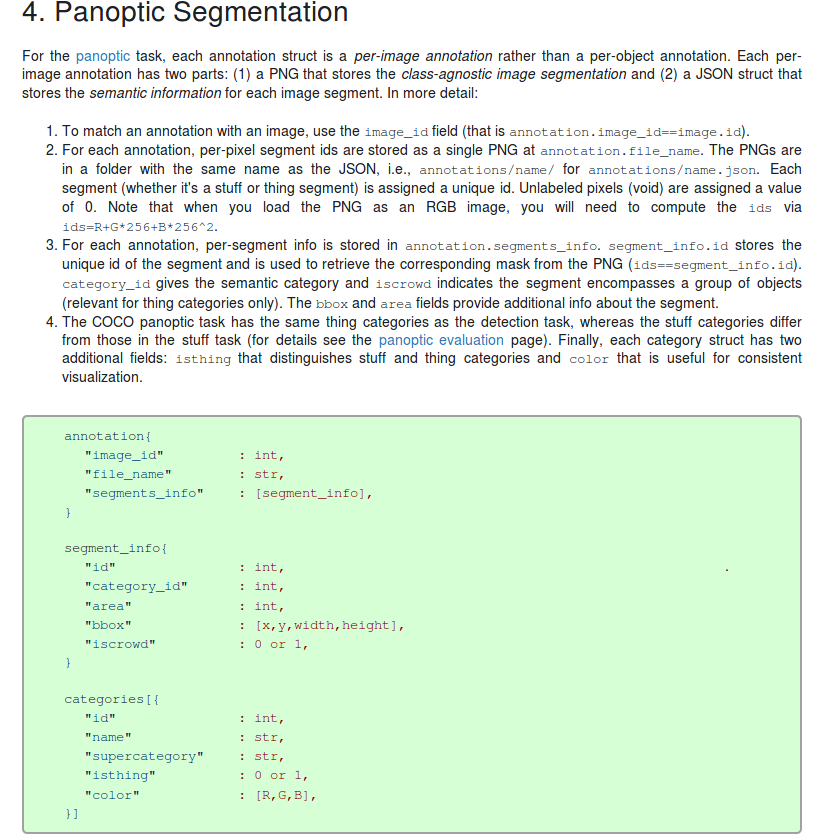COCO数据集深入理解
Object segmentation
Recognition in context
Superpixel stuff segmentation
330K images (>200K labeled)
1.5 million object instances
object categories
stuff categories
captions per image
, people with keypoints
1. 对stuff任务:118282(118K)训练,5k验证
2. 对instance任务:118k训练,instances_minival2014.json(5k)测试
3. 全景分割任务:40890(40k)训练,5k测试
数据格式
All annotations share the same basic data structure below:
{
"info": info,
"images": [image],
"annotations": [annotation],
"licenses": [license],
}

2. Stuff Segmentation
The stuff annotation format is identical and fully compatible to the object detection format above (except iscrowd is unnecessary and set to 0 by default). We provide annotations in both JSON and png format for easier access, as well as conversion scripts between the two formats. In the JSON format, each category present in an image is encoded with a single RLE annotation (see the Mask API for more details). The category_id represents the id of the current stuff category. For more details on stuff categories and supercategories see the stuff evaluation page. See also the stuff task.
注: instance和stuff任务都categorise没有isthing和color字段;

For a class-aware detector, if you feed it an image, it will return a set of bounding boxes, each box associated with the class of the object inside (i.e. dog, cat, car). It means that by the time the detector finished detecting, it knows what type of object was detected.
For class-agnostic detector, it detects a bunch of objects without knowing what class they belong to. To put it simply, they only detect “foreground” objects. Foreground is a broad term, but usually it is a set that contains all specific classes we want to find in an image, i.e. foreground = {cat, dog, car, airplane, …}. Since it doesn’t know the class of the object it detected, we call it class-agnostic.
Class-agnostic detectors are often used as a pre-processor: to produce a bunch of interesting bounding boxes that have a high chance of containing cat, dog, car, etc. Obviously, we need a specialized classifier after a class-agnostic detector to actually know what class each bounding box contains
COCO api: coco.py
def __init__(self, annotation_file=None):
"""
Constructor of Microsoft COCO helper class for reading and visualizing annotations.
:param annotation_file (str): location of annotation file
:param image_folder (str): location to the folder that hosts images.
:return:
"""
# load dataset
self.dataset,self.anns,self.cats,self.imgs = dict(),dict(),dict(),dict()
self.imgToAnns, self.catToImgs = defaultdict(list), defaultdict(list)
if not annotation_file == None:
print('loading annotations into memory...')
tic = time.time()
dataset = json.load(open(annotation_file, 'r')) # 加载进内存
assert type(dataset)==dict, 'annotation file format {} not supported'.format(type(dataset))
print('Done (t={:0.2f}s)'.format(time.time()- tic))
self.dataset = dataset
self.createIndex() def createIndex(self):
# create index
print('creating index...')
anns, cats, imgs = {}, {}, {} # 这几个都是根据字段一一对应,没有重复
imgToAnns,catToImgs = defaultdict(list),defaultdict(list)
if 'annotations' in self.dataset:
for ann in self.dataset['annotations']:
imgToAnns[ann['image_id']].append(ann) # 同一image_id可能有很多标注框
anns[ann['id']] = ann if 'images' in self.dataset:
for img in self.dataset['images']:
imgs[img['id']] = img if 'categories' in self.dataset:
for cat in self.dataset['categories']:
cats[cat['id']] = cat if 'annotations' in self.dataset and 'categories' in self.dataset:
for ann in self.dataset['annotations']:
catToImgs[ann['category_id']].append(ann['image_id']) # 将有某一种类别标注-->和所有image_id对应 print('index created!') # create class members
self.anns = anns
self.imgToAnns = imgToAnns
self.catToImgs = catToImgs
self.imgs = imgs
self.cats = cats
- 主要是实例化一个cocco对象,利用json文件初始化各种对应关系:其中图像,标注,类别id都唯一建立映射;图像id->标注,类别id->图像,存在一对多映射;
- 在通过一些其他接口处理数据
# The following API functions are defined:
# COCO - COCO api class that loads COCO annotation file and prepare data structures.
# decodeMask - Decode binary mask M encoded via run-length encoding.
# encodeMask - Encode binary mask M using run-length encoding.
# getAnnIds - Get ann ids that satisfy given filter conditions. #annotations
# getCatIds - Get cat ids that satisfy given filter conditions. #category
# getImgIds - Get img ids that satisfy given filter conditions.
# loadAnns - Load anns with the specified ids.
# loadCats - Load cats with the specified ids.
# loadImgs - Load imgs with the specified ids.
# annToMask - Convert segmentation in an annotation to binary mask.
# showAnns - Display the specified annotations.
# loadRes - Load algorithm results and create API for accessing them.
# download - Download COCO images from mscoco.org server.
- 其中loadRes将训练结果转换为coco对象(json格式);
网络输出:
[{"image_id": 139, "category_id": 1, "bbox": [418.3974914550781, 159.67330932617188, 47.4359130859375, 137.63726806640625], "score": 0.9947304725646973}, ...]
[{"image_id": 139, "category_id": 1, "segmentation": {"size": [426, 640], "counts": "cia53R==kCEj:a0mDFP;c0cDC[;X1N1O1O2N2N2N4L3M2N1O0110107YE`ML0o9Y3K5K0O3M10O0O2O1N1O2N4L5K5XNmEOY:CVF6R:^OWF=m9]O[F=g9_OdF7a9CURY2"}, "score": 0.9947304725646973}, ...]
MS COCO数据集目标检测评估(Detection Evaluation)
- 调用方法:cocoGt,cocoDt分别为coco对象
# running evaluation
cocoEval = COCOeval(cocoGt,cocoDt,annType)
cocoEval.evaluate()
cocoEval.accumulate()
cocoEval.summarize()
- cocoeval.py:
- 调试理解:
class COCOeval:
# Interface for evaluating detection on the Microsoft COCO dataset.
#
# The usage for CocoEval is as follows:
# cocoGt=..., cocoDt=... # load dataset and results
# E = CocoEval(cocoGt,cocoDt); # initialize CocoEval object
# E.params.recThrs = ...; # set parameters as desired
# E.evaluate(); # run per image evaluation
# E.accumulate(); # accumulate per image results
# E.summarize(); # display summary metrics of results
# For example usage see evalDemo.m and http://mscoco.org/.
#
# The evaluation parameters are as follows (defaults in brackets):
# imgIds - [all] N img ids to use for evaluation
# catIds - [all] K cat ids to use for evaluation
# iouThrs - [.5:.05:.95] T=10 IoU thresholds for evaluation
# recThrs - [0:.01:1] R=101 recall thresholds for evaluation
# areaRng - [...] A=4 object area ranges for evaluation
# maxDets - [1 10 100] M=3 thresholds on max detections per image
# iouType - ['segm'] set iouType to 'segm', 'bbox' or 'keypoints'
# iouType replaced the now DEPRECATED useSegm parameter.
# useCats - [1] if true use category labels for evaluation
# Note: if useCats=0 category labels are ignored as in proposal scoring.
# Note: multiple areaRngs [Ax2] and maxDets [Mx1] can be specified.
#
# evaluate(): evaluates detections on every image and every category and
# concats the results into the "evalImgs" with fields:
# dtIds - [1xD] id for each of the D detections (dt)
# gtIds - [1xG] id for each of the G ground truths (gt)
# dtMatches - [TxD] matching gt id at each IoU or 0
# gtMatches - [TxG] matching dt id at each IoU or 0
# dtScores - [1xD] confidence of each dt
# gtIgnore - [1xG] ignore flag for each gt
# dtIgnore - [TxD] ignore flag for each dt at each IoU
#
# accumulate(): accumulates the per-image, per-category evaluation
# results in "evalImgs" into the dictionary "eval" with fields:
# params - parameters used for evaluation
# date - date evaluation was performed
# counts - [T,R,K,A,M] parameter dimensions (see above)
# precision - [TxRxKxAxM] precision for every evaluation setting
# recall - [TxKxAxM] max recall for every evaluation setting
# Note: precision and recall==-1 for settings with no gt objects.
#
# See also coco, mask, pycocoDemo, pycocoEvalDemo
#
# Microsoft COCO Toolbox. version 2.0
# Data, paper, and tutorials available at: http://mscoco.org/
# Code written by Piotr Dollar and Tsung-Yi Lin, 2015.
# Licensed under the Simplified BSD License [see coco/license.txt]
def __init__(self, cocoGt=None, cocoDt=None, iouType='segm'):
'''
Initialize CocoEval using coco APIs for gt and dt
:param cocoGt: coco object with ground truth annotations
:param cocoDt: coco object with detection results
:return: None
'''
if not iouType:
print('iouType not specified. use default iouType segm')
self.cocoGt = cocoGt # ground truth COCO API
self.cocoDt = cocoDt # detections COCO API
self.params = {} # evaluation parameters
self.evalImgs = defaultdict(list) # per-image per-category evaluation results [KxAxI] elements
self.eval = {} # accumulated evaluation results
self._gts = defaultdict(list) # gt for evaluation
self._dts = defaultdict(list) # dt for evaluation
self.params = Params(iouType=iouType) # parameters
self._paramsEval = {} # parameters for evaluation
self.stats = [] # result summarization
self.ious = {} # ious between all gts and dts
if not cocoGt is None:
self.params.imgIds = sorted(cocoGt.getImgIds())
self.params.catIds = sorted(cocoGt.getCatIds())
COCO数据集深入理解的更多相关文章
- COCO数据集使用
一.简介 官方网站:http://cocodataset.org/全称:Microsoft Common Objects in Context (MS COCO)支持任务:Detection.Keyp ...
- COCO 数据集的使用
Windows 10 编译 Pycocotools 踩坑记 COCO数据库简介 微软发布的COCO数据库, 除了图片以外还提供物体检测, 分割(segmentation)和对图像的语义文本描述信息. ...
- COCO 数据集使用说明书
下面的代码改写自 COCO 官方 API,改写后的代码 cocoz.py 被我放置在 Xinering/cocoapi.我的主要改进有: 增加对 Windows 系统的支持: 替换 defaultdi ...
- Pascal VOC & COCO数据集介绍 & 转换
目录 Pascal VOC & COCO数据集介绍 Pascal VOC数据集介绍 1. JPEGImages 2. Annotations 3. ImageSets 4. Segmentat ...
- [PocketFlow]解决TensorFLow在COCO数据集上训练挂起无输出的bug
1. 引言 因项目要求,需要在PocketFlow中添加一套PeleeNet-SSD和COCO的API,具体为在datasets文件夹下添加coco_dataset.py, 在nets下添加pelee ...
- 在ubuntu1604上使用aria2下载coco数据集效率非常高
简单的下载方法: 所以这里介绍一种能照顾大多数不能上外网的同学的一种简单便捷,又不会中断的下载方法:系统环境: Ubuntu 14.04 方法: a. 使用aria2 搭配命令行下载.需要先安装: s ...
- MS coco数据集下载
2017年12月02日 23:12:11 阅读数:10411 登录ms-co-co数据集官网,一直不能进入,FQ之后开看到下载链接.有了下载链接下载还是很快的,在我这儿晚上下载,速度能达到7M/s,所 ...
- coco数据集标注图转为二值图python(附代码)
coco数据集大概有8w张以上的图片,而且每幅图都有精确的边缘mask标注. 后面后分享一个labelme标注的json或xml格式转二值图的源码(以备以后使用) 而我现在在研究显著性目标检测,需要的 ...
- Microsoft COCO 数据集
本篇博客主要以介绍MS COCO数据集为目标,分为3个部分:COCO介绍,数据集分类和COCO展示. 本人主要下载了其2014年版本的数据,一共有20G左右的图片和500M左右的标签文件.标签文件标记 ...
随机推荐
- BZOJ.1028.[JSOI2007]麻将(贪心)
题目链接 枚举对子,枚举每张牌,先出完它的刻子,剩下的出顺子.\(O(n^3)\). 不是这样 -> 出完所有刻子,最后出顺子.(日常zz) 优先仨相同的,然后顺子,有一次且一定要用一次机会补顺 ...
- 数据库事务的属性-ACID和隔离级别
1.数据库事务的属性-ACID(四个英文单词的首写字母): 1)原子性(Atomicity) 所谓原子性就是将一组操作作为一个操作单元,是原子操作,即要么全部执行,要么全部不执行. 2)一致性(Con ...
- Codeforces Round #397 by Kaspersky Lab and Barcelona Bootcamp (Div. 1 + Div. 2 combined) F. Souvenirs 线段树套set
F. Souvenirs 题目连接: http://codeforces.com/contest/765/problem/F Description Artsem is on vacation and ...
- xcode 拷贝新的ios image 进去以后 出现 the divices is locked
苹果公司时不时的给你更新下ios系统.对于开发者来说.更新xcode是灾难性的. 一直在用xcode7.3.1,可是最新不小心把手机升级到 ios 10.1.1,这下好了,真机调试不行了.提示没有镜像 ...
- git 仓库迁移,git remote 更改源
git仓库迁移 我们有时候需要迁移git仓库,但又想保留每次commit的记录,所以我们只需要更改git remote [源]的问题即可 首先查看你的remote的地址 git remote -vv ...
- FireDAC 下的 Sqlite [2] - 第一个例子
为了方便测试, 我把官方提供的 C:\Users\Public\Documents\Embarcadero\Studio\14.0\Samples\data\FDDemo.sdb 复制了一份到 C:\ ...
- Redis "MISCONF Redis is configured to save RDB snapshots, but is currently not able to persist on disk"问题的解决(转)
今天第二次遇到Redis “MISCONF Redis is configured to save RDB snapshots, but is currently not able to persis ...
- USBDM RS08/HCS08/HCS12/Coldfire V1,2,3,4/DSC/Kinetis Debugger and Programmer -- Software Install
Installation of USBDM for Windows Under Windows, installation is done with a standard Windows MSI fi ...
- 树莓派创始人访谈:我们是怎么让大家都成为DIY黑客的
原文出处: Linux.CN 请记住它是为喜欢折腾的人准备的只要35美元的计算机 我永远不会忘记我第一次看到树莓派的情形.那个小巧的,信用卡大小的计算机,性能却足够强劲,可以作为一般家用PC,媒体中心 ...
- 项目从.NET 4.5迁移到.NET 4.0遇到的问题
当把项目从.NET 4.5迁移到.NET 4.0时,遇到的问题和解决如下: 在"属性--应用程序--目标框架"设置成.NET 4.0版本. 重新生成项目,报有关EF的错: 卸载掉项 ...
